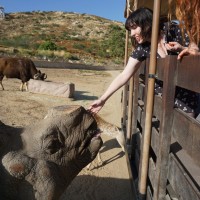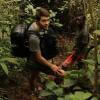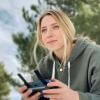With new technologies revolutionizing data collection, wildlife researchers are becoming increasingly able to collect data at much higher volumes than ever before. Now we are facing the challenges of putting this information to use, bringing the science of big data into the conservation arena. With the help of machine learning tools, this area holds immense potential for conservation practices. The applications range from online trafficking alerts to species-specific early warning systems to efficient movement and biodiversity monitoring and beyond.
However, the process of building effective machine learning tools depends upon large amounts of standardized training data, and conservationists currently lack an established system for standardization. How to best develop such a system and incentivize data sharing are questions at the forefront of this work. There are currently multiple AI-based conservation initiatives, including Wildlife Insights and WildBook, that are pioneering applications on this front.
This group is the perfect place to ask all your AI-related questions, no matter your skill level or previous familiarity! You'll find resources, meet other members with similar questions and experts who can answer them, and engage in exciting collaborative opportunities together.
Just getting started with AI in conservation? Check out our introduction tutorial, How Do I Train My First Machine Learning Model? with Daniel Situnayake, and our Virtual Meetup on Big Data. If you're coming from the more technical side of AI/ML, Sara Beery runs an AI for Conservation slack channel that might be of interest. Message her for an invite.
Header Image: Dr Claire Burke / @CBurkeSci

Explore the Basics: AI
Understanding the possibilities for incorporating new technology into your work can feel overwhelming. With so many tools available, so many resources to keep up with, and so many innovative projects happening around the world and in our community, it's easy to lose sight of how and why these new technologies matter, and how they can be practically applied to your projects.
Machine learning has huge potential in conservation tech, and its applications are growing every day! But the tradeoff of that potential is a big learning curve - or so it seems to those starting out with this powerful tool!
To help you explore the potential of AI (and prepare for some of our upcoming AI-themed events!), we've compiled simple, key resources, conversations, and videos to highlight the possibilities:
Three Resources for Beginners:
- Everything I know about Machine Learning and Camera Traps, Dan Morris | Resource library, camera traps, machine learning
- Using Computer Vision to Protect Endangered Species, Kasim Rafiq | Machine learning, data analysis, big cats
- Resource: WildID | WildID
Three Forum Threads for Beginners:
- I made an open-source tool to help you sort camera trap images | Petar Gyurov, Camera Traps
- Batch / Automated Cloud Processing | Chris Nicolas, Acoustic Monitoring
- Looking for help with camera trapping for Jaguars: Software for species ID and database building | Carmina Gutierrez, AI for Conservation
Three Tutorials for Beginners:
- How do I get started using machine learning for my camera traps? | Sara Beery, Tech Tutors
- How do I train my first machine learning model? | Daniel Situnayake, Tech Tutors
- Big Data in Conservation | Dave Thau, Dan Morris, Sarah Davidson, Virtual Meetups
Want to know more about AI, or have your specific machine learning questions answered by experts in the WILDLABS community? Make sure you join the conversation in our AI for Conservation group!
- @bioNathan
- | he/him
Innovation Design Engineer studying at MSc + MA level. Previously a Robotics engineer with specialisms in remote sensing, control systems & electronics design. Transitioning to ecological contexts. I use bioinspiration to inform tech design, both product & infrastructure.
- 0 Resources
- 0 Discussions
- 8 Groups
Dzanga-Ndoki national park biodiversity monitoring



- 0 Resources
- 55 Discussions
- 10 Groups
Tech 4 Conservation
President, Tech 4 Conservation
- 0 Resources
- 5 Discussions
- 18 Groups
- @kalado
- | Kalado
- 0 Resources
- 0 Discussions
- 8 Groups
Botswana Predator Conservation Trust



- 0 Resources
- 72 Discussions
- 10 Groups
Quantitative ecologist @ Biotope
- 0 Resources
- 0 Discussions
- 4 Groups
- @donovantye
- | He/Him
Savanna Ecologist, Field Station Director and Head of Conservation Tech Projects for Organization for Tropical Studies (OTS).
- 0 Resources
- 0 Discussions
- 14 Groups
- @IsobelAshbey
- | She/her/hers
Running a Tech for Good initiative at Cambridge Consultants, looking for organisations who need help developing new technology for conservation


- 0 Resources
- 7 Discussions
- 5 Groups
- @Seagoose
- | she/her
Ecologist & Conservationist. Women for the Environment, Africa Fellow. National Geographic Explorer.
- 0 Resources
- 4 Discussions
- 8 Groups
Conservation technology enthusiast

- 0 Resources
- 3 Discussions
- 14 Groups
- @siddharth119
- | He/Him
Nature lover from MA
- 0 Resources
- 0 Discussions
- 1 Groups
- @kaitlyngaynor
- | she/her, they/them
- 0 Resources
- 0 Discussions
- 3 Groups
Careers
The Smithsonian National Zoo & Conservation Biology Institute is seeking a Program Manager to help coordinate multiple organizations in an effort to integrate movement data & camera trap data with global...
22 April 2024
The Smithsonian National Zoo & Conservation Biology Institute is seeking a Postdoctoral Research Fellow to help us integrate movement data & camera trap data with global conservation policy.
22 April 2024
Join the Seeed Vision Challenge, an opportunity for conservation innovators to harness the power of AI vision sensors for environmental monitoring and protection.
10 April 2024
Full-Stack Software Developer (Python/React) - Specializing in AI/ML for Wildlife Conservation
5 April 2024
Article
Article from Ars Technica about how difficult it is to detect and avoid kangaroos...
3 April 2024
18 month postdoc research position, Netherlands, EU-funded
28 March 2024
Article
You’re invited to the WILDLABS Variety Hour, a monthly event that connects you to conservation tech's most exciting projects, research, and ideas. We can't wait to bring you a whole new season of speakers and...
22 March 2024
Join our multi-national team at the AI for Biodiversity Change Global Climate Center! We're hiring a Research Data Manager & Tech Coordinator at Ohio State. Support cutting-edge research on climate change &...
15 March 2024
Catch up on the conservation tech discussions and events that happened during World Wildlife Day 2024!
7 March 2024
EcoAssist introduces a free African species identification model for camera trap images, capable of recognising 30 species.
5 March 2024
Join us to help prevent biodiversity loss! Understory is hiring a postdoc to lead R&D Development on generalizing Computer Vision models for vegetation identification across space/time/phenotypes.
29 February 2024
Join the Luxembourg Institute of Science and Technology (LIST) in pioneering environmental and ecological monitoring! 🌍💡 As part of ERIN’s Observatory for Climate, Environment, and Biodiversity (OCEB), you'll be at the...
26 February 2024
April 2024
event
September 2024
event
October 2024
September 2023
event
event
| Description | Activity | Replies | Groups | Updated |
|---|---|---|---|---|
| In an earlier post in this discussion, I wondered how the funders are responding. Today, I stumbled on the following Request for Expressions of Interest for short term consultancy... |
+36
|
AI for Conservation, Emerging Tech | 2 minutes 37 seconds ago | |
| Hey Sol, No problem at all. Depending on your configuration, the Audiomoth software would have to work on a PCB with an ESP32 chip which is the unit on the audiomoth/... |
|
Acoustics, AI for Conservation, Data management and processing tools, Emerging Tech, Sustainable Fishing Challenges | 1 day 3 hours ago | |
| Hi, this is pretty interesting to me. I plan to fly a drone over wild areas and look for invasive species incursions. So feral hogs are especially bad, but in the Everglades there... |
|
AI for Conservation, Camera Traps, Open Source Solutions, Software and Mobile Apps | 1 day 4 hours ago | |
| That was one of the things I was wondering about, the height that it can resolve animals at. At some resolution it must be able to tell different animals apart. My... |
|
AI for Conservation | 1 day 5 hours ago | |
| In my experience, the preference for trapping animals using different types of snares varies depending on factors such as traditional customs, geographical location, availability... |
+8
|
AI for Conservation, Drones, Emerging Tech, Human-Wildlife Conflict, Wildlife Crime | 3 days 8 hours ago | |
| Gotcha, well I look forward to seeing future iterations and following along with your progress!! |
|
Autonomous Camera Traps for Insects, AI for Conservation, Emerging Tech, Open Source Solutions | 3 days 9 hours ago | |
| Hi everyone!@LashaO and @holmbergius from the Wild Me team at ConservationX Labs gave a superb talk at last month's Variety Hour,... |
|
AI for Conservation, Camera Traps | 5 days 11 hours ago | |
| Hi everyone! @zhongqimiao was kind enough to join Variety Hour last month to talk more about Pytorch-Wildlife, so the recording might be of interest to folks in this thread. Catch... |
+5
|
AI for Conservation, Camera Traps, Open Source Solutions | 5 days 11 hours ago | |
| Thanks Carly! I will keep anyone interested in this project posted on this platform. Cheers |
|
Acoustics, AI for Conservation | 5 days 11 hours ago | |
| Greetings Everyone, We are so excited to share details of our WILDLABS AWARDS project "Enhancing Pollinator Conservation through Deep... |
|
AI for Conservation, Autonomous Camera Traps for Insects | 2 weeks 1 day ago | |
| EcoAssist is an application designed to streamline the work of ecologists dealing with camera trap images. It’s an AI platform that... |
|
Software and Mobile Apps, AI for Conservation, Camera Traps | 2 weeks 5 days ago | |
| We could always use more contributors in open source projects. In most open source companies Red Hat, Anaconda, Red Hat and Mozilla, people often ended up getting hired largely... |
|
Acoustics, AI for Conservation, Conservation Tech Training and Education, Early Career, Marine Conservation | 4 weeks ago |
Call for Papers: Special Issue on Computer Vision Approach for Animal Tracking and Modeling
 International Journal of Computer Vision
International Journal of Computer Vision
20 September 2021 12:00am
Tech Tutors: How do I use AI to fight wildlife crime?
1 September 2021 10:59pm
Which are major open challenges that AI can help to solve in nature conservation ?
28 April 2021 9:15am
13 August 2021 10:04pm
Elizabeth Bondi has work on detection from thermal imagery taken by drones! I'd look at her papers :)
27 August 2021 10:51am
Looks good, but what is the added value compared to other examples as Obsidentify and Plantnet?
AI/ML Engineer Job at Dryad
26 August 2021 2:45pm
Widening the Bottleneck: Can Citizen Science Accelerate Conservation?
 Whale Seeker
Whale Seeker
19 August 2021 12:00am
Open positions in ML & conservation/climate sci
18 August 2021 2:22pm
Geo for Good Lightning Talks: Nature Conservation
 Google Earth Outreach
Google Earth Outreach
17 August 2021 12:00am
Building Sustainable Support with Edge Impulse
 Ellie Warren
Ellie Warren
13 August 2021 12:00am
Accessible Tech and Real Impact with the WILDLABS Fellowship: On the Edge
 Ellie Warren
Ellie Warren
9 August 2021 12:00am
WILDLABS Community Call: August 12th
4 August 2021 12:00am
Tech Tutors: How do I get started with Wildlife Insights?
29 July 2021 12:04am
Wildlife Insights Launches
 Wildlife Insights
Wildlife Insights
27 July 2021 12:00am
Tech Tutors: How do I get started with Megadetector?
22 July 2021 3:34pm
Opportunity: Lead an ML Workshop
 Edge Impulse
Edge Impulse
21 July 2021 12:00am
How do I get started with Wildlife Insights?
 Nicole Flores
Nicole Flores
19 July 2021 12:00am
How do I get started with Megadetector?
 Siyu Yang
Siyu Yang
7 July 2021 12:00am
How do I choose the right camera trap(s) based on interests, goals, and species?
 Marcella Kelly
Marcella Kelly
6 July 2021 12:00am
WILDLABS Tech Tutors: Season 3
6 July 2021 12:00am
BearID Featured: Artificial Intelligence & Other New Technology In Bear Research
1 July 2021 12:00am
PhDs (or MSc) in tech + nature conservation ?
28 April 2021 9:16am
26 May 2021 5:09pm
I think programming and machine learning are what I wish I did in uni the most. Particularly Python coding. Most biologists use R/Rstudio but Python is more popular in the tech world. And machine learning is taking over everything, conservation included, so it's definitely a high-demand skill.
26 May 2021 9:14pm
carlybatist, I can help with python. Is there anything you or people in your network may need help?
About ML - can you tell 3 main challenges you'd think as priority in conservation, that ML can be helpful ? Also, anything that also small NGOs may struggle to work on, due to limited budget / IT capacity, and so they may benefit from freelancers ? Large NGOs or international agencies will likely work with established companies. I'ìd like to know if there could be a niche were I can interact directly with NGOs and philantropic institutions, both for supporting with services, as well for listening to feedback to project proposals that could benefit from mutual collaborations (e.g. tech pilot + fundraising = startup and product iterations with lower costs).
Also, can you mention a few activities / roles that may offer both outdoor + analytics / tech skills ?
Piorirty is outdoor for me. But since I have a few tech skills and management skills, im trying to trade them!
26 May 2021 10:04pm
You should join the Key Conservation app, which connects people and NGO's for specific needs, whether funding, time, or skills (programming included). Organizations can list particular things they need and you can get day-to-day updates on progress.
In terms of how ML is used in conservation, it's mostly to process the large datasets yielded by conservation tech (camera traps, passive acoustics, biologging, remote sensing/GIS). Annotating detections (which pictures have animals, which species a call belongs to, where deforestation is happening through satellite imagery, etc.).
And lots of freelancing opportunities come up in Wildlabs - the community threads and the biweekly digest. Twitter is also great for finding those kinds of opportunities, search by relevant keywords or hashtags (e.g., #tech4wildlife). I would also start following conservation tech organizations on LinkedIn and Twitter or subscribing to their newsletters or listservs so you don't miss opportunities as they come up.
New Papers: Methods in Ecology and Evolution
 British Ecological Society
British Ecological Society
23 April 2021 12:00am
New Papers: Remote Sensing in Ecology and Conservation
 Remote Sensing in Ecology & Conservation
Remote Sensing in Ecology & Conservation
22 April 2021 12:00am
BirdCLEF 2021 Kaggle Challenge
 The Cornell Lab of Ornithology
The Cornell Lab of Ornithology
19 April 2021 12:00am
Looking for animal emotions data for ML
17 March 2021 12:43pm
26 March 2021 4:06pm
There is a TON of research on ML algorithms for all this!
For facial rec-
BearID project - http://bearresearch.org/ (individual facial rec for grizzlies)
AnimalFACS (facial action coding system) - http://www.chimpfacs.com/ (the model started with chimps but they now have versions for orangutans, gibbons, macaques, dogs, cats, and horses)
A lot of the gesture/facial expression literature is focused on primates, particularly apes, so if you do a Google Scholar search on that, you'll loads of papers that have looked into this as well.
For vocals -
Carlson, N. V., Kelly, E. M., & Couzin, I. (2020). Individual vocal recognition across taxa: a review of the literature and a look into the future. Philosophical Transactions of the Royal Society B, 375(1802), 20190479.
Turesson, H. K., Ribeiro, S., Pereira, D. R., Papa, J. P., & de Albuquerque, V. H. C. (2016). Machine learning algorithms for automatic classification of marmoset vocalizations. PloS one, 11(9), e0163041.
Wijers, M., Trethowan, P., Du Preez, B., Chamaillé-Jammes, S., Loveridge, A. J., Macdonald, D. W., & Markham, A. (2020). Vocal discrimination of African lions and its potential for collar-free tracking. Bioacoustics, 1-19.
Clink, D. J., Crofoot, M. C., & Marshall, A. J. (2019). Application of a semi-automated vocal fingerprinting approach to monitor Bornean gibbon females in an experimentally fragmented landscape in Sabah, Malaysia. Bioacoustics, 28(3), 193-209.
Spillmann, B., van Schaik, C. P., Setia, T. M., & Sadjadi, S. O. (2017). Who shall I say is calling? Validation of a caller recognition procedure in Bornean flanged male orangutan (Pongo pygmaeus wurmbii) long calls. Bioacoustics, 26(2), 109-120.
Hantke, S., Cummins, N., & Schuller, B. (2018, April). What is my dog trying to tell me? The automatic recognition of the context and perceived emotion of dog barks. In 2018 IEEE International Conference on Acoustics, Speech and Signal Processing (ICASSP) (pp. 5134-5138). IEEE.
Totakura, V., Janmanchi, M. K., Rajesh, D., & Hussan, M. T. (2020). Prediction of Animal Vocal Emotions Using Convolutional Neural Network. International Journal of Scientific & Technology Research, 9(2), 6007-6011.
Other -
Neethirajan, S., Reimert, I., & Kemp, B. (2021). Measuring Farm Animal Emotions—Sensor-Based Approaches. Sensors, 21(2), 553.
Hong, W., Kennedy, A., Burgos-Artizzu, X. P., Zelikowsky, M., Navonne, S. G., Perona, P., & Anderson, D. J. (2015). Automated measurement of mouse social behaviors using depth sensing, video tracking, and machine learning. Proceedings of the National Academy of Sciences, 112(38), E5351-E5360.
26 March 2021 7:44pm
Thank you VERY much for that, Carly. I really appreciate it. I have only heard of the bear research project and was not aware of the others. This is very helpful.
FYI: Most studies I am aware of use ML with facial recognition software. I am interested to find out if there are recognition software/research for facial-gesture-voice-speech as this will be more accurate to read animals that have less elastic facial expressions than primates or humans.
The 2021 #Tech4Wildlife Photo Challenge: Community Highlights
25 March 2021 12:00am
Event: tinyML for Good: Conservation & Climate
 Edge Impulse
Edge Impulse
22 March 2021 12:00am
Allen Coral Atlas - using machine learning to map coral reefs
17 March 2021 6:48pm
Building Experts Into AI
 Whale Seeker
Whale Seeker
15 March 2021 12:00am
Kaggle Competition: iWildcam 2021 - FGVC8
 CVPR
CVPR
12 March 2021 12:00am
Funding Opportunity: COVID-19 Science Fund
 National Geographic
National Geographic
10 March 2021 12:00am
















































4 August 2021 5:00pm
I would perhaps ask this in a new thread, so the rest of the community can see it! (as opposed to a reply here, where only the people in the conversation are notified of more replies).